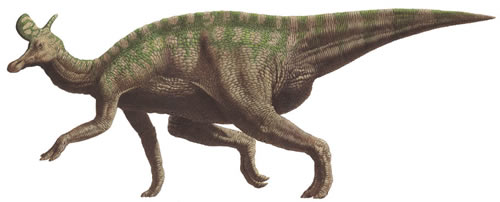Lambeosaurus lambei - Heribivore Dinosaurs
Homepage > Herbivore Dinosaurs - Lambeosaurus lambei
(lam-bee-oh-sor-uhss)
"Lambe's lizard "
Describer Parks, 1923
Also Known As --
Type of Species lambei
Order Ornithischia
SubOrder --
InfraOrder --
Micro-Order --
Family Hadrosauridae
Size 50 feet (15.2 meters) long
Period late Cretaceous, 72 million years ago
Fossilsite Montana, USA; Alberta, Canada; Mexico
Diet Herbivore
Lambeosaurus lambei lived during the Late Cretaceous Period, 72 million years ago in what is now Montana, Alberta and Mexico. Lambeosaurus was one of the largest crested duckbill dinosaurs. This dinosaur was distinguishable by different bony crests on their tops of their heads, in much the same way the different kinds of modern deer and antelope have different antlers or horns. The shape of their heads may have varied with age and gender. Lambeosaurus' crests were hollow and contained paired canals that connected to their nostrils. By blowing air through this canals, this herbivores may have been able to communicate with other members of the herd or intimidated rival predators.

Nearly twenty skulls and skeletons of Lambeosaurus have been described. A large fossil deposit containing hundreds of jumbled up skeletons that may have been buried by floods, includes specimens of Lambeosaurus lambei along with Corythosaurus, Prosaurolophus, Gryposaurus, and Parasaurolophus, this suggests that these duckbill dinosaurs shared the same habitat and may have even migrated in huge mixed herds. Some Lambeosaurus fossils displayed detail impressions of skin, and that a we-like sheath of skin joined the fingers. The web actually enclosed a fleshy pad on the palm like the one found on modern camels today.